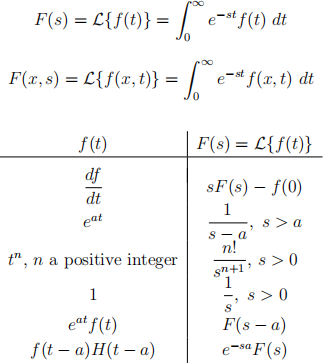MATHS 361 Partial Differential Equations SEMESTER ONE, 2022
Hello, dear friend, you can consult us at any time if you have any questions, add WeChat: daixieit
MATHS 361
SEMESTER ONE, 2022
MATHEMATICS
Partial Differential Equations
The formulas below may be used without proving them.
1. Laplace transforms

2. Fourier transforms
1. (14 marks)
(a) Let f (x) be the piecewise function defined as
f (x) = ![]() 1
1 ![]() 1--xx<<10,
1--xx<<10,
Define F (x) as the periodic extension of f (x). The function F (x) has period two. The Fourier Series for F (x) can be written as
![]() bn cos
bn cos ![]()
Find bn , n = 1, 2, . . ..
(b) Define EN (x) as the error
EN (x) = ![]() bn cos
bn cos ![]() < F (x)
< F (x)
Sketch the graph of Eì↓ for x ∈ [<1.5, 1.5] by hand. Do not use a computer program to find the graph.
(c) How would the graph E4↓ differ from the graph of Eì↓ ? Justify your answer.
2. (18 marks) Let u(x, t) denote the solution to the pde
ut = uxx + u, 0 < x < 1, t > 0,
with the boundary conditions u(0, t) = 0, u(1, t) = 1, and the initial conditions u(x, 0) = sin(πx/2).
(a) Find the steady-state solution us (t).
(b) Let U (x, t) = u(x, t) < us (x). Find the partial differential equation for U. Then find the boundary conditions and initial conditions for U.
(c) Use the Separation of Variables technique to find the general solution for U that satisfies the boundary conditions for U.
(d) Suppose the initial conditions u(x, 0) = sin(πx/2) were changed to u(x, 0) = x(1 < x). How would the general solution from the previous part of the question change? Justify your answer.
3. (8 marks) Consider the problem
uxx + ugg = 0, 0 < x,y, < 2,
u(0, y) = 0 u(2, y) = 1,
u(x, 0) = 0, u(x, 2) = 0.
(a) The eigenfunctions for this problem can be written as the product of a sinh function and a sin function. Will the sin function be of the form sin αnx or sin βny where αn and βn are suitably chosen constants? Use the boundary conditions for the problem to justify your answer. Do not find the general solution to the problem.
(b) The boundary condition u(2, y) = 1 gives u(2, 2) = 1, and the boundary condition u(x, 2) = 0 gives u(2, 2) = 0. Hence the boundary conditionsimply u has a discontinuity at (2, 2). Can the Separation of Variables technique be used to solve the above problem? Justify your answer.
4. (20 marks) Consider the diffusion equation
ut = uxx , 0 < x < o , 0 < t < o
with the boundary conditions
u(x, 0) = f (x)
ux (0, t) = 0
u o 0 as x, t o o
(a) Explain why it is difficult to solve this problem using Laplace transforms methods.
(b) Solve this equation using Fourier transforms. You may have to extend the domain to achieve this. Your final answer will be a convolution.
ut + 2ux = 0, u(x, 0) = <1, u(0, t) = 1
Your friend claims that a weak solution to this equation is: u(x, t) = 1 when t > x and u(x, t) = <1 if t - x.
(a) What does your friend mean when they claim u is a weak solution? Write out their claim as an integral equation using the definition of weak solutions. Because u(x, t) is defined piecewise, it may be useful to break your integral up into two separate integrals.
(b) Evaluate your integral equation in order to demonstrate that u(x, t) is not a valid weak solution for the equation given.
6. (20 marks) Consider the partial differential equation
ut + 2ux = 0, u(x, 0) = <1, u(0, t) = t.
(a) Find the Laplace transform of this equation and hence show that U (x, s) = < ![]() + C(s)e′sx/2. Here we have transformed our t variable.
+ C(s)e′sx/2. Here we have transformed our t variable.
(b) Use your remaining boundary condition, along with the table of Laplace transforms provided to determine u(x, t).
7. (20 marks) For this question you are asked to find the Greens function G(x, x↓ ) such that ∆G = δ(x < x↓ ) inside the semicircle domain S shown below, and G(x, x↓ ) = 0 on the boundary of S.

(a) Give a diagram illustrating where you would place delta functions in order to produce such a Green’s function.
(b) What is the equation for this Green’s function? (Hint: the table at the start of the exam has examples of Green’s functions in y, y2 and y3 )
(c) Explain why you can’t use reflections to find a G(x, xR ) such that G(x, xR ) = 0 on the boundary of the semicircle, and ∆G = δ(x < xR ) outside of the semicircle.
2023-06-12